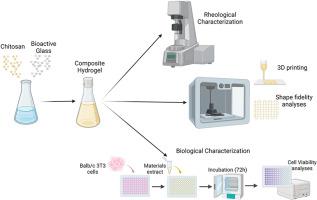Precision 3D printing of chitosan-bioactive glass inks: Rheological optimization for enhanced shape fidelity in tissue engineering scaffolds
Q1 Computer Science
引用次数: 0
Abstract
3D printing technology in tissue engineering applications provides several advantages for scaffold development, especially with natural materials, such as chitosan, which provides a biomimetic environment for cellular growth. However, chitosan hydrogel-based inks still show poor printing fidelity. In this article, we overcame this challenge by incorporating bioactive glasses (BG) nanoparticles (up to 5 wt%) into the chitosan hydrogel. The resulting inks were characterized by rheological tests, while their processability was evaluated through measurements of shape fidelity. An indirect cytotoxicity assay was also conducted to evaluate the cell viability of the printed scaffolds. The results indicated that adding BG nanoparticles to the chitosan-based ink modified its rheological properties and improved its shape-fidelity during 3D printing, which we suggest are consequences of hydrogen bonds established between the glass and the chitosan chains. Also, cytotoxicity assessment demonstrated that the resulting scaffold exhibits high cell viability. In conclusion, the proposed composite ink has optimized rheological properties for 3D printing and is promising for applications in tissue engineering.

壳聚糖生物活性玻璃油墨的精密三维打印:流变学优化提高组织工程支架的形状保真度
组织工程应用中的三维打印技术为支架开发提供了多种优势,尤其是天然材料,如壳聚糖,它能为细胞生长提供仿生环境。然而,基于壳聚糖水凝胶的油墨仍然显示出较低的打印保真度。在本文中,我们通过在壳聚糖水凝胶中加入生物活性玻璃 (BG) 纳米颗粒(最多 5 wt%)来克服这一难题。我们通过流变学测试对所得油墨进行了表征,并通过形状保真度测量对其加工性进行了评估。此外,还进行了间接细胞毒性试验,以评估印刷支架的细胞活力。结果表明,在壳聚糖基墨水中添加 BG 纳米粒子可改变其流变特性,并改善其在 3D 打印过程中的形状保真度,我们认为这是玻璃和壳聚糖链之间建立氢键的结果。此外,细胞毒性评估表明,生成的支架具有很高的细胞活力。总之,所提出的复合油墨具有优化的三维打印流变特性,有望应用于组织工程。
本文章由计算机程序翻译,如有差异,请以英文原文为准。
求助全文
约1分钟内获得全文
求助全文
来源期刊

Bioprinting
Computer Science-Computer Science Applications
CiteScore
11.50
自引率
0.00%
发文量
72
审稿时长
68 days
期刊介绍:
Bioprinting is a broad-spectrum, multidisciplinary journal that covers all aspects of 3D fabrication technology involving biological tissues, organs and cells for medical and biotechnology applications. Topics covered include nanomaterials, biomaterials, scaffolds, 3D printing technology, imaging and CAD/CAM software and hardware, post-printing bioreactor maturation, cell and biological factor patterning, biofabrication, tissue engineering and other applications of 3D bioprinting technology. Bioprinting publishes research reports describing novel results with high clinical significance in all areas of 3D bioprinting research. Bioprinting issues contain a wide variety of review and analysis articles covering topics relevant to 3D bioprinting ranging from basic biological, material and technical advances to pre-clinical and clinical applications of 3D bioprinting.
 求助内容:
求助内容: 应助结果提醒方式:
应助结果提醒方式:


